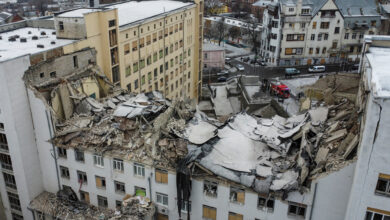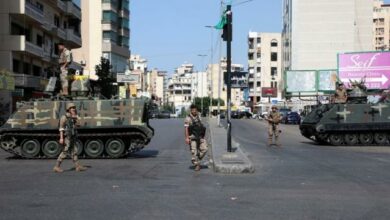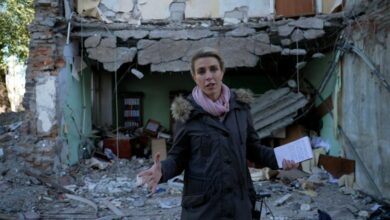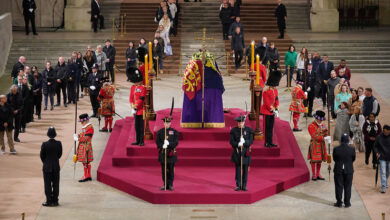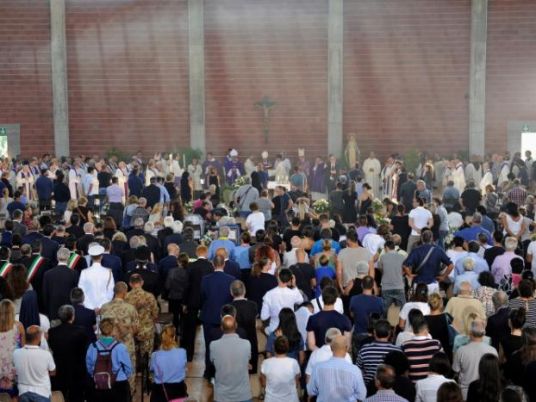
Weeping relatives hugged each other and reached out to touch the simple wooden coffins at a state funeral on Saturday for some of the 291 people killed in an earthquake this week.
Amongst the 35 coffins laid out in a sports hall were small caskets holding the bodies of an 18-month-old baby and a nine-year-old girl, two of the 21 children who are known to have died when the quake hit central Italy early on Wednesday.
"Don't be afraid to bewail your suffering, we have seen so much suffering. But I ask you not to lose your courage," Bishop Giovanni D'Ercole said in a homily in the hall, which was packed with grieving families and top politicians.
"Only together can we rebuild our houses and churches. Above all, together we can give life back to our communities," he said, speaking in front of a dusty crucifix salvaged from one of the dozens of churches devastated by the quake.
Even as the funeral Mass was being held, rescuers kept searching through the rubble of the worst-hit town, Amatrice, but acknowledged they had little hope of finding more survivors from Italy's worst earthquake in seven years.
Nine more bodies were recovered from the town on Saturday, including three pulled overnight from the crumpled Hotel Roma, bringing the death toll in Amatrice alone to 230 residents and tourists.
Authorities said 387 people were still in hospital, with one patient dying of his injuries during the day.
One of the last people to be plucked alive from the debris was a girl called Giorgia, who turned four on Saturday. Her sister Giulia's small coffin lay in the center of the sports hall for the funeral Mass.
"Hello little one," said a handwritten note left on her coffin by one of the rescue team that retrieved her body.
"I am sorry that we arrived late. You had already stopped breathing, but I want you to know up there that we did all we could to get you out of there."
Investigation
Relatives of the dead sat on chairs next to the coffins or knelt on the floor, their arms resting on the caskets, which were covered in flowers. One man, his legs covered in cuts, sat in a wheelchair, his head bowed. Some of the mourners clutched framed photos of their loved ones.
As the names of the dead were read out, hundreds of people outside the sweltering sports hall broke into prolonged applause in a sign of solidarity with the families.
Italian President Sergio Mattarella and Prime Minister Matteo Renzi lingered after the service had ended to talk to the ranks of mourners.
"We will decide all together how to get going again. But don't give up, that is crucial," Renzi told one youth.
Authorities have released the names of 181 victims. The youngest was five months old, the oldest 93. Six Romanians, three Britons, a Spanish woman, a Canadian and an Albanian died in the calamity.
Most of the buildings in the quake zone had no anti-seismic protection, but even some of those that did, including a school in Amatrice that was renovated in 2012, fell apart.
Magistrates have opened an investigation into some of the incidents, including the collapse of a belltower in the town of Accumoli, which smashed through the roof of an adjacent building killing a family of four.
"What happened cannot just be considered fate," said prosecutor Giuseppe Saieva, who is leading the probe. "If these buildings had been constructed like they are in Japan then they would not have collapsed," he told la Repubblica newspaper.
Renzi has promised to rebuild the shattered communities and the mayor of Amatrice urged the government to learn the lessons of painfully slow post-quake reconstructions of the past.
"What we need is a reconstruction in record time. It is a great opportunity for politicians to show extraordinary commitment," mayor Sergio Pirozzi told president Mattarella.
Survivors in some of the worst-hit areas feared that their little hamlets, sparsely populated outside the holiday months, would become ghost towns unless the flattened Amatrice was swiftly rebuilt.
"That's where the grocery stores, shops and restaurants were, and these little villages depended on it," said Eduardo Nibi, 31, whose family has roots in the badly-damaged hamlet of San Lorenzo e Flaviano.
Aftershocks continued to rattle the area overnight, the strongest measuring 4.2. The Italian geological institute said more than 1,350 aftershocks had hit Italy's central mountains since Wednesday's pre-dawn 6.2-magnitude quake.
Italy sits on two faultlines, making it one of the most seismically active countries in Europe. Almost 30 people died in earthquakes in northern Italy in 2012 and more than 300 in the city of L'Aquila in 2009.

